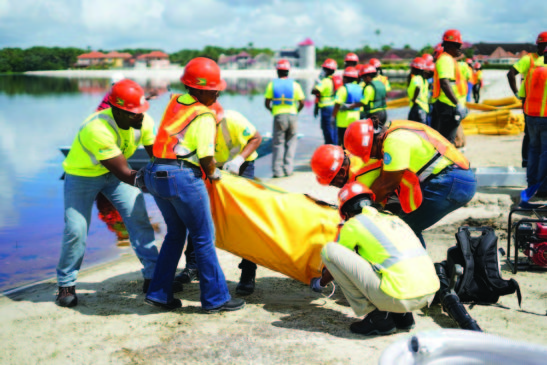
By Jarryl Bryan
The National Oil Spill Contingency Plan (NOSCP) was supposed to be completed by early November but that has not materialised. According to a top official from the Civil Defence Commission (CDC), a number of factors have caused the plan’s completion to be pushed back.
In an interview with this publication, CDC Director Major Kester Craig explained that one major factor in the delay was the additional comments they got from various stakeholders. Another factor was the manpower and resources that were diverted by the CDC to combat the recent effects of overtopping and flooding in coastline communities.
These contributors included the operators themselves, such as ExxonMobil, Tullow and Repsol, as well as local government bodies like Regional Democratic Councils (RDCs) and Government agencies.
“At the last conference, I had indicated that the national oil spill plan should have been completed and sent to Cabinet for review and approval. We had some setbacks, mainly because tremendous comments after we circulated the plan to several stakeholders that we are going through and reviewing and trying as much as possible to incorporate”.
“Because at the end of the day, we want to ensure we have a plan that takes into consideration the entire needs of all those stakeholders, ensure there is transparency and ensure we account for the entire large stakeholders, not just at the national level but the community level,” he added.
To give an idea of the amount of feedback they got, he explained that at one point, dozens of stakeholders were reviewing the document section by section. And according to Craig, the CDC was asked to review certain sections of the plan.
Craig explained that owing to the numerous comments, they had to come up with a system to weed out repetition and optimise the recommendations coming in to ensure that they were in line with international best practices.
“But what also happened, about a week after the plan, Guyana was impacted by overtopping of sea defences and the Civil Defence team was actually engaged day and night, for almost two and a half weeks, responding to emergencies and real-life events,” Craig also explained.
“So because of that, we had to change our course of action and place more emphasis on real issues, which would directly impact the environment and the livelihood of people. But now that we’ve regained some normalcy now, we’ve begun putting some effort into completing the plan”.
No impediment
Nevertheless, Craig assured that the lack of a completed policy does not stop the relevant authorities from acting in the unfortunate event of a spill. Moreover, he promised that the plan would be ready and presented to Cabinet by the time first oil arrives.
“Even though the plan has not been approved, it’s still an operational document. Which means the players that developed the plan are aware of their roles and responsibilities. So if, God forbids, something should happen, people know what they have to do in terms of responding and coordination”.
Since Exxon announced its oil find in the Liza-1 well in the Stabroek Block in 2015, a pertinent question has been the capacity of the relevant agencies to protect the environment in case of an oil spill. It is a topic that has regularly been raised at public lectures.
An Environmental Protection Agency (EPA) study had found that while an oil spill was possible, factors such as the location of ExxonMobil affiliates’ operations, combined with the region’s water temperature would minimise the effects.
Originally scheduled for 2020, the projected start of first oil production has been moved up to next month. A Floating Production, Storage and Offloading (FPSO) vessel has already arrived in Guyana’s waters, with Dutch firm SBM Offshore constructing a second one for offshore Guyana.
Work has been ongoing on the oil spill plan since last year, with the CDC leading the way and engaging relevant stakeholders over a number of months. The third draft of the plan was recently released for perusal. Among the components of that draft was a three-tier system of dealing with oil spills.
There is a tier-one level that deals with the local and facility-level response; the tier-two level is a national response to the oil spill and the regional and international response to an oil spill.



